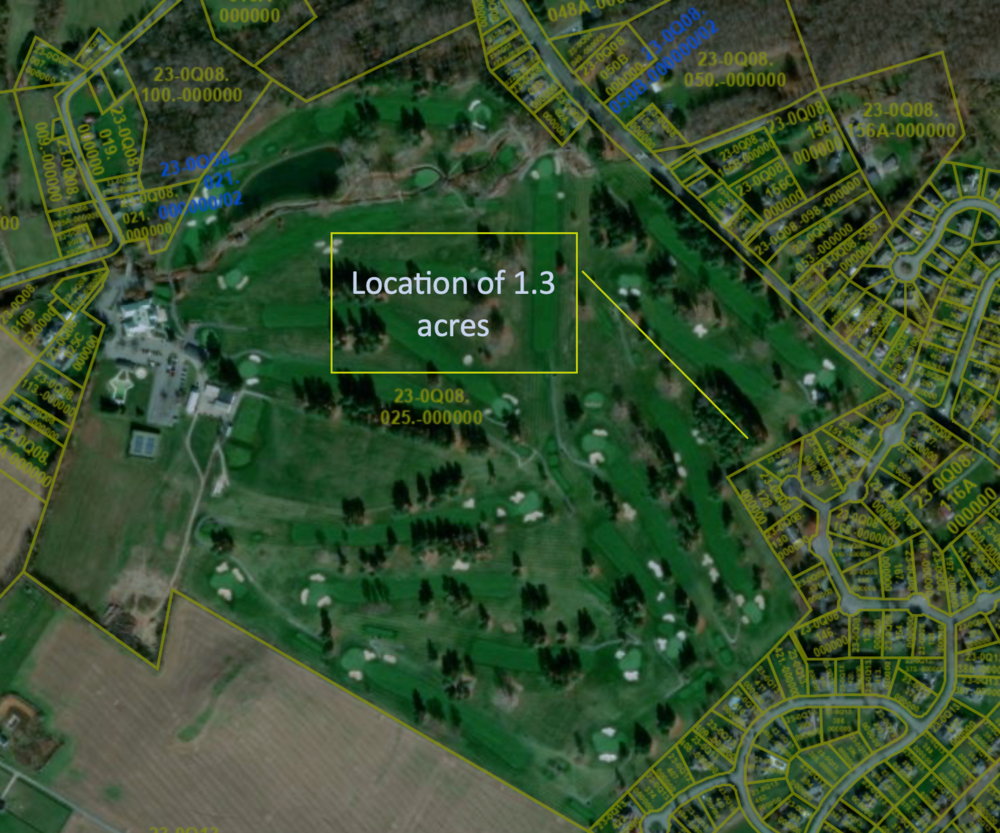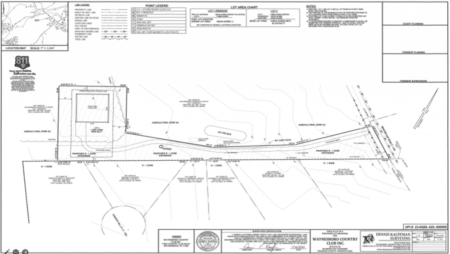WASHINGTON TOWNSHIIP – There is nothing quite like a local rezoning hearing when it comes to motivating residents to engage in civic affairs. And this was evident on Monday, Nov. 18, when Washington Township Supervisors approved a request from Waynesboro Country Club to rezone 1.3 acres from agricultural to residential.
Supervisors met at a regularly scheduled meeting at 1:30 p.m. Four of five supervisors were present: Chairman Charlie Strausbaugh and supervisors Stewart McCleaf, Scott Stine and Barb McCracken. Ted Snowberger was absent.
Although there was a full agenda of routine material, a moderately contested rezoning request from the Waynesboro Country Club Board dominated attention with a formal hearing.
The Country Club board members have seized what they feel is an opportunity. They have seen a turn for the better in their financial situation since hiring Steve Glossinger in 2019 to manage the club. Glossinger is a well-known manager with an impressive resume. Many in the area have commented on substantial improvements in the course since his arrival. The board wanted to recognize his performance and take steps to secure his services for an extended period.
With this in mind, they negotiated what amounts to a bonus and an incentive package. It includes sale of 1.3 acres of course land at market value to Glossinger, who intends to build a home in that space. The loan for the land is with the club. It is partially forgiven each year as part of his employment. The deal includes incentives for Glossinger to remain as club manager for 10 years.
To do this, the board needed to rezone the land in question from agricultural to R1, low density housing. The land is located on the eastern end of the club’s property, adjoining Country Club Estates, which is also zoned R1.

The idea is to take a small segment of the wooded area between holes 13 and 14 for the home. In order to comply with township zoning criteria, an R1 property will need a panhandle to provide access. In this case, the panhandle would come off Mentzer Gap Road east of the holes and along the back of several Country Club Estates properties.
The close proximity to Country Club Estates is what made the proposal contentious. Five residents spoke against the proposal, and four letters were read into the record, also in opposition. The five property owners along the proposed action were represented by attorney Kate Rohrbaugh, an associate for Barley Snyder.

Objections fell into several categories:
- Concern for spot zoning and lack of due process: The general rule for zoning of this kind is to address two or more acres. The point of avoiding spot zoning is to prevent arbitrary and unreasonable actions and to promote the health and welfare of the area. An ongoing legal action was cited.
- Concern for a drop in property values. Joel Elhadge was there to speak to changes in property values. He shared that there would be an impact of some kind, but his analysis will not be complete for another four weeks. He would not speculate on how much.
- One resident of 22 years had been displaced once before and had chosen the current location because it backed up to a golf course. That speaker did not want things to change.
- Another resident of more than 40 years noted the proposed house and road will result in traffic behind his home. He was concerned for the precedent being set and did not want his view of the course and mountain obstructed.
- A third point concerned potential environmental and storm water management concerns. Flooding in some yards during heavy rain was cited as a current problem that could be exascerbated by a house and access road.
- There were questions about moving the cite further north along Mentzer Gap nearer the tee boxes for hole 12.
Local lawyer Jim Stein, acting as a Country Club board member and not in his legal capacity, presented the case for rezoning. His rebuttal to the above questions included:
- There is nothing arbitrary about the proposal. The Country Club is asking permission for the change in accordance with established procedures in public session. He also observed that the court case in question does not prohibit spot zoning, and that the country club does benefit the public with its long-term viability (since 1928) and the many golf teams (Mt. St Mary’s and the high school) and charitable events (tournaments, fund raisers, etc.) hosted at the facility.
- He could not guarantee that things would not change, but he pointed out that efforts to sustain the country club would help keep change to a minimum. He argued that if the club failed, the most likely outcome would be land development for much more housing than is proposed here.
- He and Glossinger clarified their intentions, which included temporarily widening an existing five-foot path along the proposed panhandle to eight feet for construction, then returning it to a path as his driveway. No road is proposed. As to the view, the house would be within the boundaries of the existing wooded area so will not result in any lost views of the course or the mountain. Rohrbaugh countered that a panhandle needs to be 20-feet wide. Stein agreed, but recalled that only the access need be 20-feet wide. The path is to be much thinner.
- Stein agreed that storm water was an issue but said that needs to be addressed during construction per current ordinances and laws. He also said the golf course is actually lower than Country Club Estates properties so did not see how a house built on lower land would result in any more water impact than it already has, if any.
- On property values, their contention was that the home and path, being constructed to support minimal traffic and change in view, should have little or no impact on values.
After an hour the hearing was closed, and the meeting returned to regular session. Supervisors began asking questions.
McCleaf asked about the club’s intentions for other developments of this sort. Stein replied there are none at this time, though he conceded they cannot guarantee anything forever.
McCleaf asked about the ongoing case, which is taking place in the Mechanicsburg area. He also asked if there was any other case law on matters like this. Stein said he was not aware of any, and Rohrbaugh did not disagree.
Strausbaugh observed that if they did this again, they would need another 20-foot panhandle for the new property but was advised this is moot since there are no other plans of this sort.
Stine recalled some old plans to develop club property behind the tennis courts. Stein answered saying the board has no current desire to take up those old plans.
In response to several questions about Glossinger’s intentions, he offered that he intends to stay here and to retire here.
McCleaf made a motion to table this discussion temporarily so that the supervisors could take it up in executive session before proceeding. They departed for an alternate conference room at 2:42 p.m. and returned at 3:09 p.m.
On return, Chairman Strausbaugh announced that as a club member and a resident of Country Club Estates, he would abstain from voting on this question.
McCleaf made a motion to approve the club’s requested rezoning. Stine seconded.
What followed were procedural motions to approve an ordinance concerning the zoning change and to bring the Township Comprehensive Plan into alignment with the rezoning decision. These all passed unanimously.
At 3:13 p.m. the supervisor meeting returned to its regular agenda.
A word about “hearings”
Hearings follow a fairly strict process. In this case, after the regular meeting was called to order, a formal hearing was called into session.
This is distinct from the regular meeting. Its purpose is to get the facts, interests and thoughts of all interested parties on the record. All those who intend to speak are sworn in, including staff members and citizens.
Township supervisors do not ask questions nor do they entertain them during a hearing. Their purpose is to “hear” what is presented. Many times this is misunderstood by citizens as a reluctance to discuss the topic. It is not. It is simply a way to give individuals a chance to speak their piece without interruption. At township and borough levels which are so close to the public, this is sometimes a difficult task as many of those in the room know each other, including the supervisors. The discussion is simply set aside until the hearing is closed.
When all have spoken, the hearing is closed, supervisors re-enter their regular session and a more traditional dialogue takes place.






















